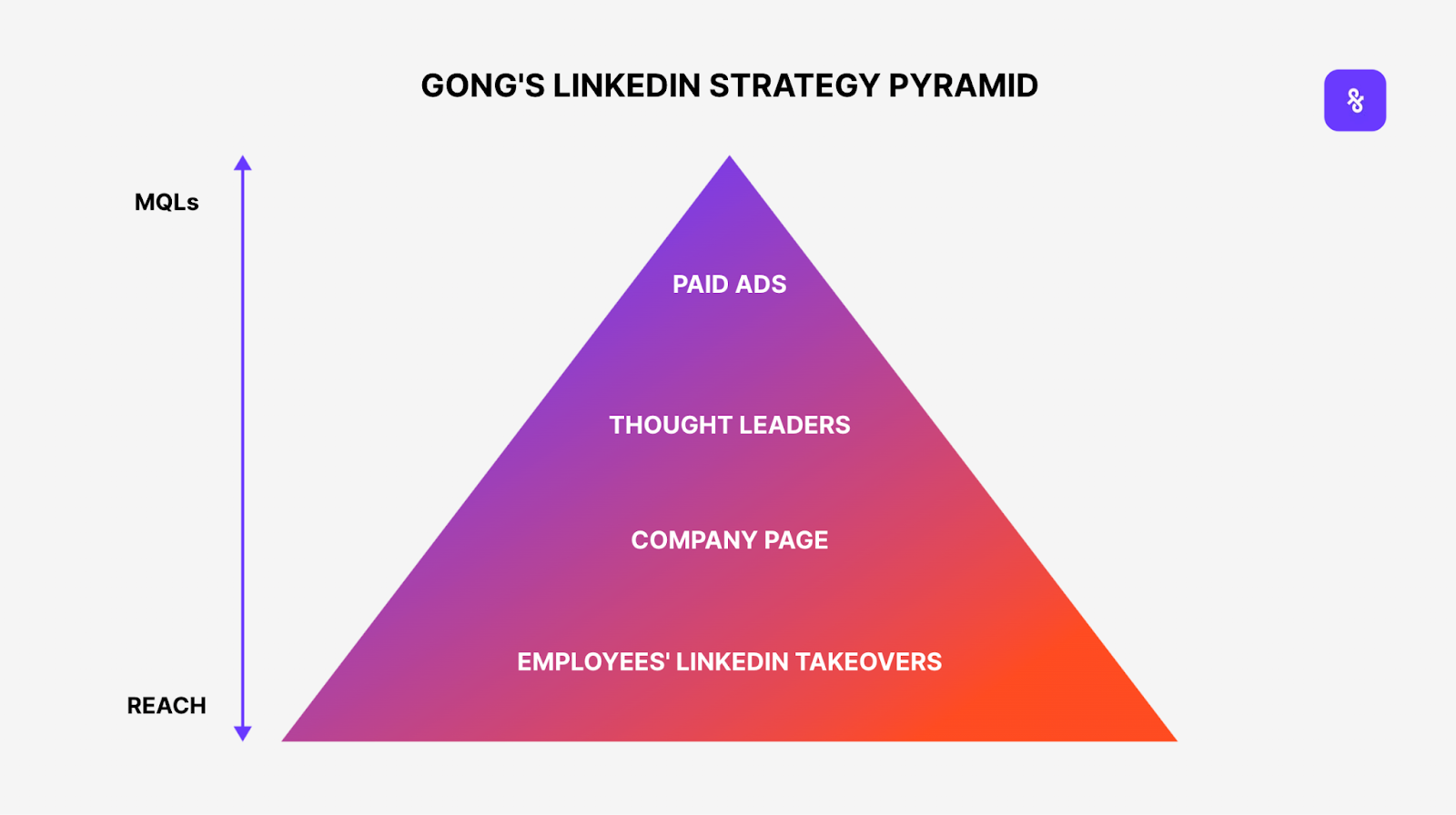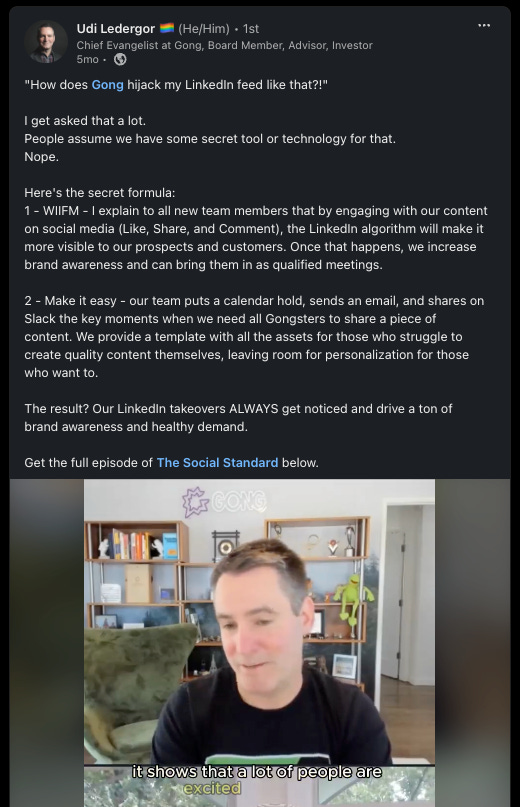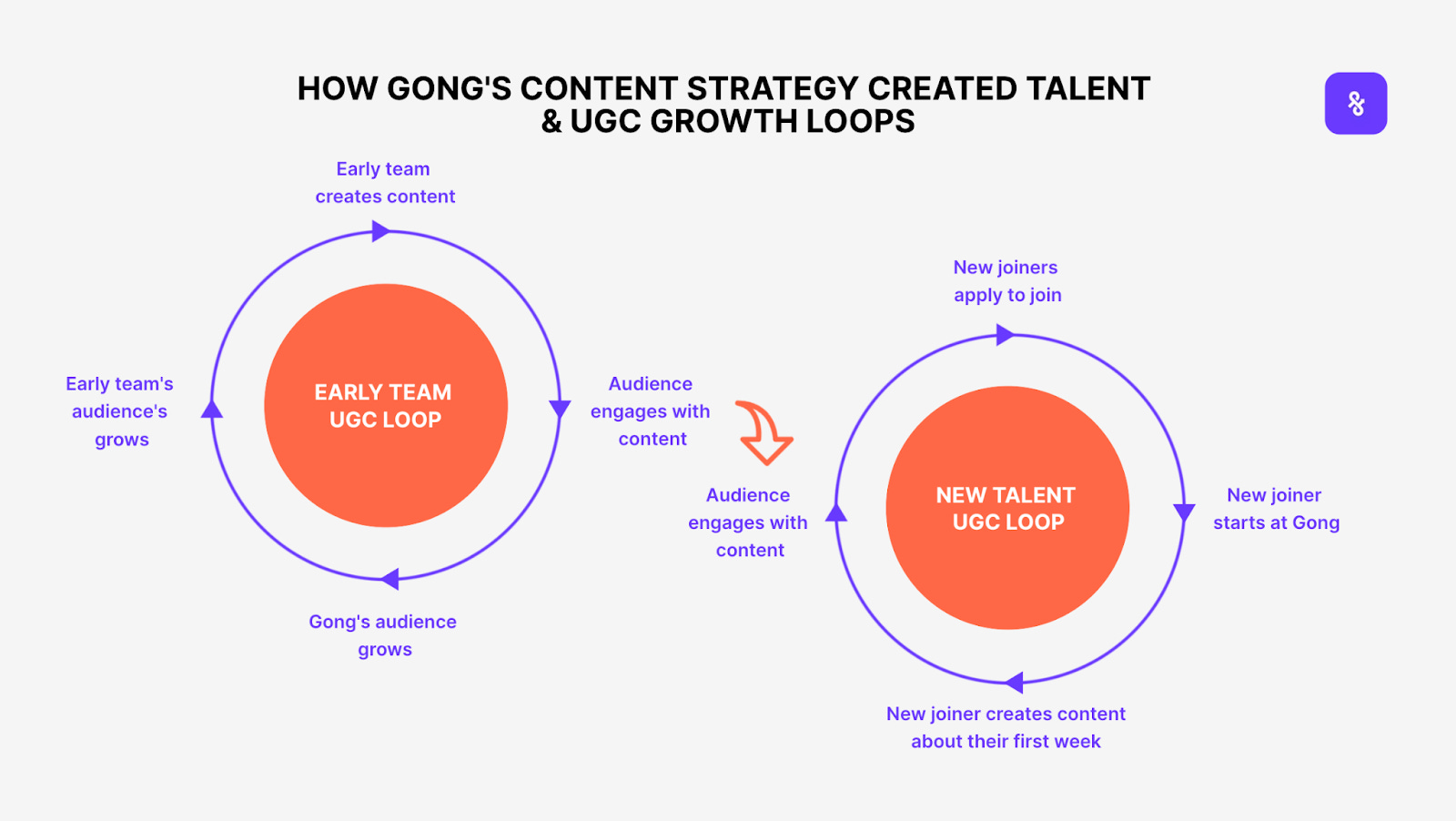Gong’s LinkedIn Takeovers Playbook
How to Maximize LinkedIn’s Presence to Generate and Capture Demand
Today, LinkedIn is the premier B2B social selling platform. Still, it remains a hard-to-measure channel with tons of noise and competition, requiring time and dedication to grow. However, if you do it right you can drive a ton of "free" awareness, build a demand gen layer, and turn it into an actual acquisition channel, not just a brand one.
Back in 2022, Gong used LinkedIn to make the company look ahead of where it really was, leading it to dominate the Revenue Intelligence category, which at the time was still in the making.
Gong needed their audience to be comfortable with recording sales calls — and doing so with Gong over other alternatives — so LinkedIn helped make sales call recording and analysis desirable for sales leaders and positioning Gong as the leader in that space.
During the COVID years, Gong created the playbook of LinkedIn takeovers, with their CMO Udi Ledergor and CEO Amit Bendov becoming the archetype of founder-led marketing on LinkedIn. They did so also out of the realization that Gong’s audience (sales and marketing teams) — ”live” on LinkedIn. That’s why it’s key to go all in on the platform and build a native LinkedIn brand.
In this post, we’ll pull the curtain on Gong’s playbook and speak directly with Jonathan Costet, who built and executed Gong’s LinkedIn playbook back in 2020, growing the company page to over 200,000 followers in just over 2 years.
Let’s dive in!
1. Encourage Employees to Takeover LinkedIn
Gong's prime social strategy stood out for its LinkedIn takeovers. They managed to mobilize employees across every level and team to consistently post on LinkedIn, literally taking over the platform and creating mindshare. This was a great tactic to scale the brand’s organic mentions while decentralizing content creation efforts beyond just the “executive thought leaders”.
Jonathan and the team were smart to root these takeovers into employees’ peak engagement moments. For example, they encouraged new hires to share a post about their first week at Gong. By coordinating tens of these posts to go live on the same day, they gained momentum around the LinkedIn algo while ensuring the content was genuine and resonated with the audience.
This strategy wasn't limited to new hires, though. Gong capitalized on every pivotal moment of their story — company retreats, events, new content, product launches, end-of-financial years, and fundraising. The more moments they could leverage and get the entire org to create content, and tell their story and unique POV, the bigger their mindshare became.
Given the higher reach that the LinkedIn platform would give to personal pages over company pages, Gong was able to drive awareness beyond anything that could have been achieved from the corporate page alone.
Folks seeing these takeovers asked Gong’s CMO: “How do you do this? All I can see on my feed is purple”. He openly stated that without these takeovers, they’d have never built this million-eyeball reach.
Another key aspect was focusing solely on LinkedIn instead of following a cross-platform approach. This focus not only streamlined the takeover process and aligned the team’s efforts but also recognized LinkedIn's unmatched value in connecting with Gong’s target audience — B2B sales and RevOps leaders.
So how did they manage to create such a muscle and encourage people to post? First, they made it clear in their hiring process that LinkedIn content and personal branding are key company values and activities of the day-to-day. That:
It’s not just Marketing’s job to post on LinkedIn, but their core responsibility is to train and empower everyone to do so. Because when everyone spreads the word about Gong’s mission, everyone gains.
Things like drafting prompts, adding reminders on everyone’s calendar, hosting content enablement sessions, and sending 1-to-1 and 1-to-many Slack messages all drove bottom-up participation across the org. From the top down, managers encouraged their teams to engage consistently, reinforcing a culture of personal branding; and also leading by example by creating their content.
Executing this strategy early on in Gong’s journey paid off as they scaled. On the one hand, it trained the first cohorts of employees to become ambassadors who eventually turned into several LinkedIn micro-influencers with tens of thousands of followers each. On the other hand, it created a virtuous cycle that attracted talent who understood the benefits of content creation and personal branding, scaling this muscle into a proper internal UGC loop.
According to Jonathan: “This didn't happen by design, but it was a by-product of the strategy being so successful”.
2. Embrace Thought Leadership from Multiple Layers
To effectively encourage the whole company to regularly create content, you must have your entire executive team lead by example.
Thought leadership shouldn't rest solely on the CEO's shoulders. Each thought leader can reach and influence different layers of the target audience in their unique ways — be it the CMO, CEO, Head of Content, BDRs, and Sales leaders — by articulating nuanced insights and POVs from their day-to-day work. Every one of these perspectives helped expose Gong to a broad audience and showcase the value of different use cases/personas
Realizing the potential of a brand with cross-layer thought leadership, Jonathan deeply involved the whole executive team in their content strategy and trained them to generate and formulate opinions around their areas of expertise, passions, and hobbies, to create content and make it an integral layer of the overall strategy.
This is a great tactic to maintain the momentum of the LinkedIn takeovers, leading by example with the wider organization. But also, it’s a strategy to shape more than one conversation across different levels of seniority within the target function — C-level, head of department, and ICs — to reach more segments of your target customer and influence buying decisions from different angles.
When you’re considering purchasing Gong, and you need to get buy-in across champions and economic buyers, it helps that each of these actors already knows who their Gong’s counterparts are, because they see their marketing and sales leaders sharing insightful stuff on LinkedIn. It builds affinity and trust, which influences purchasing decisions.
Need some help creating your content strategy to take over LinkedIn and generate pipeline? Our team of advisors can help.
3. Build a Company Page with a Unique Brand Voice
LinkedIn takeovers and thought leaders accounts were complemented by a clear strategy for the Gong’s Company Page, which boiled down to one keyword — edutainment, or a combination of entertainment and education.
If you’re around LinkedIn today, it’s common to see creators posting insightful flowcharts on one day, and a funny meme the following one. That’s edutainment or zero-click content. And Gong was nothing short of a pioneer in executing this.
How do you build a brand voice? You think of it as a real person. What are they interested in? What would they talk about? What would they sound like? Which keywords would they use? Based on these answers, Jonathan and the team devised specific topics and copywriting styles to create Gong’s unique brand voice, including things like opinions, catchphrases, use of caps, and line breaks.
The team did a great job at optimizing the company’s page content balancing familiarity and consistency on one hand — so that even if you take your company’s logo out, people will still know whose post it is — while testing new topics and content that drives novelty and shapes new conversations.
To appeal to the LinkedIn algo, every post across all account types is optimized for short-form, and aimed to keep conversations on LinkedIn, keeping the engagement within the platform rather than redirecting traffic elsewhere, like we see these days with the typical “link in the comments”. This small tactic compounded the brand's reach and engagement organically.
4. Complement with Conversion-Focused Ads
The final component of the strategy was amplifying organic reach with conversion-focused paid campaigns, which can more effectively target elusive decision-makers like CROs and VPs of Sales.
With organic providing millions of dollars worth of reach and awareness, the Gong team was able to focus the budget on demand gen, engaging decision makers at top accounts with a mix of content/product offers.
They set up their creative strategy to address the most painful pain points of the more senior target, and then deliver a compelling call to action to close the loop. These include whitepaper downloads, recorded demos, and product tours via Navattic, as well as free trials and demo signups.
Additionally, the campaign ensures that the creative visualizes the customer's pain points and hints at how the product UI could solve them. The Gong’s team was also one of the first beta testers of a killer LinkedIn Ads feature that is becoming popular these days — thought leader ads. This unique feature boosts organic posts with LinkedIn-level granular targeting. Another great tactic to reach the right people, compound social proof, and scale influence.
Unlike other channels, LinkedIn is uniquely positioned to drive high-value leads at hard-to-break-into accounts. By driving awareness through organic posts, the paid team was able to focus exclusively on prospecting into key decision-makers in top accounts.
Closing thoughts
To dominate on LinkedIn, companies must craft a unique brand voice, engage authentically with their audience at scale and from different perspectives, and seamlessly integrate brand awareness with conversion-focused demand gen.
By focusing on quality content that educates and entertains, businesses can scale organic reach and build a brand that stands out from the crowd. And then use paid marketing to drive highly targeted MQLs from decision-makers in key accounts.
As we all know, LinkedIn can be a powerful growth engine much more than a social platform. Gong’s unique approach shows in detail how your company and team can do the same, fostering lasting connections with key decision-makers, and driving pipeline.










